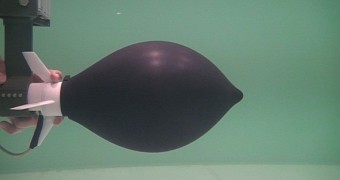Octopi go around by sucking in and then rapidly expelling water. Researchers from the University of Southampton, MIT and the Singapore-MIT Alliance for Research and Technology have decided to harness that principle.
Underwater robots and vehicles can be of two types: the normal ones, with a hard body and a propeller of some kind to move around, and the soft ones that take less conventional approaches.
Over the years, many ideas have been thrown around and tested for soft-bodied miniature underwater vehicles, and some have even been used in documentaries. There is always room for new ideas, however, so here is the latest one.
The balloon-based submarine vehicle
If you happen to be one of the people who read the scientific journal Bioinspiration and Biomimetics, you probably already know about this invention.
Researchers primarily from the University of Southampton, with help from MIT and the Singapore-MIT Alliance for Research and Technology, have created something that looks like an inflatable toy. But appearances are deceiving.
In truth, this is a submarine robot of sorts, which moves around like an octopus: it draws in water, then releases it for propulsion.
The 3D-printed polycarbonate skeleton is completely rigid, but it is covered by an outer elastic envelope (the balloon in question) which is inflated with water through an external pump.
When released from the pump, the water rushes out and propels the model forward at great bursts of speed.
Overall, the model measures 11.8 inches, or 30 cm in length. It has fins at the back, to let it move in a straight line. The balloon never deflates enough to become limp and unstreamlined because of the same skeleton holding everything together.
All in all, it should be able to move forward 10 of its own body lengths in less than a second, beyond what any other submersible can hope to achieve.
Practical applications
The model should be easy enough to use for the creation of remote operated vehicles (ROVs), autonomous underwater vehicles (AUVs) and other submersibles.
“Man-made underwater vehicle are designed to be as streamlined as possible, but with the exception of torpedoes, which use massive amounts of propellent, none of these vehicles achieve speeds of even a single body length per second or accelerations of 0.1g, despite significant mechanical complexity,” said Dr Gabriel Weymouth, Lecturer for the Southampton Marine and Maritime Institute at the University of Southampton.

 14 DAY TRIAL //
14 DAY TRIAL // 